美国法典
- 格式:doc
- 大小:76.00 KB
- 文档页数:13
![美国法典(UnitedStatesCode)简介[管理资料]](https://uimg.taocdn.com/2c3950d09fc3d5bbfd0a79563c1ec5da50e2d602.webp)
美国法典(United States Code)简介美国法典(United States Code)简介美国任何一部法律的产生首先由美国国会议员提出法案,当这个法案获得国会通过后,将被提交给美国总统给予批准,一旦该法案被总统批准(有可能被否决)就成为法律(Act)。
当一部法律通过后,国会众议院就把法律的内容公布在美国法典上。
1926年美国人将建国二百多年以来国会制定的所有立法(除独立宣言、联邦条例和联邦宪法外)加以整理编纂,按50个项目系统地分类编排,命名为《美国法典》(United States Code,简称USC),首次以15卷的篇幅发表,这是第一版《美国法典》。
1964年又出版了修订版,以后每年还出增刊。
(一)《美国法典》的体系与结构该法典根据法律规范所涉及的领域和调整对象,划分为50个主题或“部”(Title)。
它们依次是:总则、国会、总统、国旗,国玺,政府部门和联邦各州、政府组织与雇员、担保债务(现已废除)、农业、外国人与国籍、仲裁、武装力量、破产、银行与金融、人口普查、海岸警卫、商业与贸易、资源保护、版权、犯罪与刑事程序、关税、教育、食品与药品、对外关系、公路、医院与收容所、印第安人、财政收入、麻醉性酒精、司法和司法程序、劳工、矿藏和采矿、货币与财政、国民警卫、航运与可航水域、海军(现已废除)、专利、宗教习俗、规制行业薪金与津贴、退伍军人救济金、邮政事业、公共建筑、公共合同、公共卫生与福利、公共土地、国家印刷品与文献、铁路、航运、电报,电话和无线电报,领土与岛屿所有权、交通、战争与国防。
(除前六个总领性主题外,其余主题均按照A、B、C、D……的字母顺序依次排列)在50个主题之下,法典依次分为卷、章、部分、节、条等,法典最大的组成单位是卷,每一个主题对应一卷。
每卷、章、部分、节、条都用简短的文字作题注。
每条均用编号标注其来源,即哪一届国会通过的哪一部法律的哪一条,或者哪一届国会进行的修改。
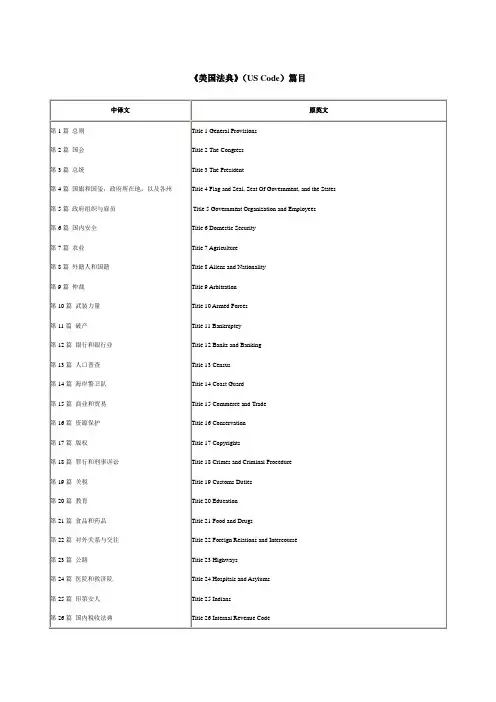
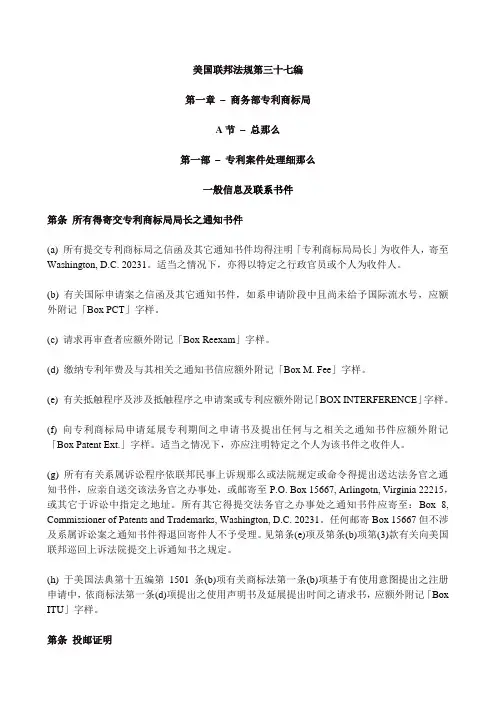
美国联邦法规第三十七编第一章–商务部专利商标局A节–总那么第一部–专利案件处理细那么一般信息及联系书件第条所有得寄交专利商标局局长之通知书件(a) 所有提交专利商标局之信函及其它通知书件均得注明「专利商标局局长」为收件人,寄至Washington, D.C. 20231。
适当之情况下,亦得以特定之行政官员或个人为收件人。
(b) 有关国际申请案之信函及其它通知书件,如系申请阶段中且尚未给予国际流水号,应额外附记「Box PCT」字样。
(c) 请求再审查者应额外附记「Box Reexam」字样。
(d) 缴纳专利年费及与其相关之通知书信应额外附记「Box M. Fee」字样。
(e) 有关抵触程序及涉及抵触程序之申请案或专利应额外附记「BOX INTERFERENCE」字样。
(f) 向专利商标局申请延展专利期间之申请书及提出任何与之相关之通知书件应额外附记「Box Patent Ext.」字样。
适当之情况下,亦应注明特定之个人为该书件之收件人。
(g) 所有有关系属诉讼程序依联邦民事上诉规那么或法院规定或命令得提出送达法务官之通知书件,应亲自送交该法务官之办事处,或邮寄至P.O. Box 15667, Arlingotn, Virginia 22215,或其它于诉讼中指定之地址。
所有其它得提交法务官之办事处之通知书件应寄至:Box 8, Commissioner of Patents and Trademarks, Washington, D.C. 20231。
任何邮寄Box 15667但不涉及系属诉讼案之通知书件得退回寄件人不予受理。
见第条(e)项及第条(b)项第(3)款有关向美国联邦巡回上诉法院提交上诉通知书之规定。
(h) 于美国法典第十五编第1501条(b)项有关商标法第一条(b)项基于有使用意图提出之注册申请中,依商标法第一条(d)项提出之使用声明书及延展提出时间之请求书,应额外附记「Box ITU」字样。
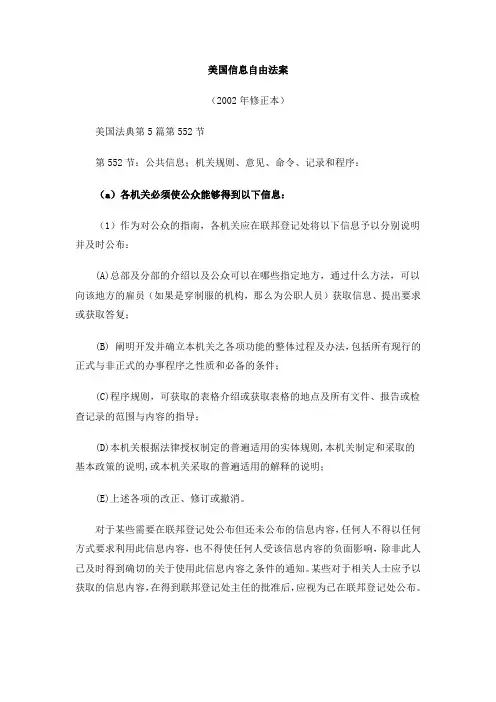
美国信息自由法案(2002年修正本)美国法典第5篇第552节第552节:公共信息;机关规则、意见、命令、记录和程序:(a)各机关必须使公众能够得到以下信息:(1)作为对公众的指南,各机关应在联邦登记处将以下信息予以分别说明并及时公布:(A)总部及分部的介绍以及公众可以在哪些指定地方,通过什么方法,可以向该地方的雇员(如果是穿制服的机构,那么为公职人员)获取信息、提出要求或获取答复;(B) 阐明开发并确立本机关之各项功能的整体过程及办法,包括所有现行的正式与非正式的办事程序之性质和必备的条件;(C)程序规则,可获取的表格介绍或获取表格的地点及所有文件、报告或检查记录的范围与内容的指导;(D)本机关根据法律授权制定的普遍适用的实体规则,本机关制定和采取的基本政策的说明,或本机关采取的普遍适用的解释的说明;(E)上述各项的改正、修订或撤消。
对于某些需要在联邦登记处公布但还未公布的信息内容,任何人不得以任何方式要求利用此信息内容,也不得使任何人受该信息内容的负面影响,除非此人已及时得到确切的关于使用此信息内容之条件的通知。
某些对于相关人士应予以获取的信息内容,在得到联邦登记处主任的批准后,应视为已在联邦登记处公布。
(2)依据已公布规则,各机关有义务提供给公众进行查阅与复制的公开信息有:(A)在案件裁决中做出的最后意见,包括赞成与反对意见及裁定书;(B)那些被本机关所采纳的未在联邦登记处公布的政策声明及其解释;(C)职员手册和对职员的指示,其中影响公众的部分;(D)依据(a)分节第(3)款,向数人公开后,由于其内容的关系,本机构决定使他们成为或将成为今后公开的任何形式或格式的文件复制件;(E)本款(D)分款中提及的文件的综合索引。
除非上述文件被及时地公布以及它们的副本供出售,对于1996年11月1日或此后形成的文件,本机构在一年之内应予以公布,包括通过计算机远程通讯手段等设备向公众公布,如果没有该设备,可用其它的电子手段。
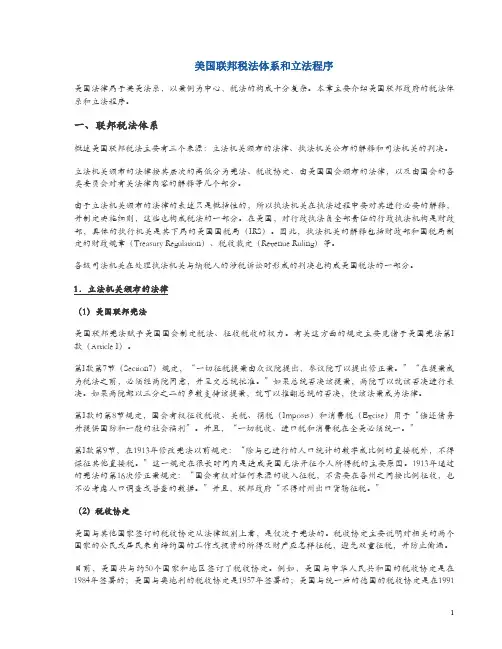
美国联邦税法体系和立法程序美国法律属于英美法系,以案例为中心,税法的构成十分复杂。
本章主要介绍美国联邦政府的税法体系和立法程序。
一、联邦税法体系概述美国联邦税法主要有三个来源:立法机关颁布的法律、执法机关公布的解释和司法机关的判决。
立法机关颁布的法律按其层次的高低分为宪法、税收协定、由美国国会颁布的法律,以及由国会的各类委员会对有关法律内容的解释等几个部分。
由于立法机关颁布的法律的表述只是概括性的,所以执法机关在执法过程中要对其进行必要的解释,并制定实施细则,这些也构成税法的一部分。
在美国,对行政执法负全部责任的行政执法机构是财政部,具体的执行机关是其下属的美国国税局(IRS)。
因此,执法机关的解释包括财政部和国税局制定的财政规章(Treasury Regulation)、税收裁定(Revenue Ruling)等。
各级司法机关在处理执法机关与纳税人的涉税诉讼时形成的判决也构成美国税法的一部分。
1.立法机关颁布的法律(1)美国联邦宪法美国联邦宪法赋予美国国会制定税法、征收税收的权力。
有关这方面的规定主要见诸于美国宪法第I 款(Article I)。
第I款第7节(Section7)规定,“一切征税提案由众议院提出,参议院可以提出修正案。
”“在提案成为税法之前,必须经两院同意,并呈交总统批准。
”如果总统否决该提案,两院可以就该否决进行表决。
如果两院都以三分之二的多数支持该提案,就可以推翻总统的否决,使该法案成为法律。
第I款的第8节规定,国会有权征收税收、关税、捐税(Imposts)和消费税(Excise)用于“偿还债务并提供国防和一般的社会福利”。
并且,“一切税收、进口税和消费税在全美必须统一。
”第I款第9节,在1913年修改宪法以前规定:“除与已进行的人口统计的数字成比例的直接税外,不得课征其他直接税。
”这一规定在很长时间内是造成美国无法开征个人所得税的主要原因。
1913年通过的宪法的第16次修正案规定:“国会有权对任何来源的收入征税,不需要在各州之间按比例征收,也不必考虑人口调查或普查的数据。
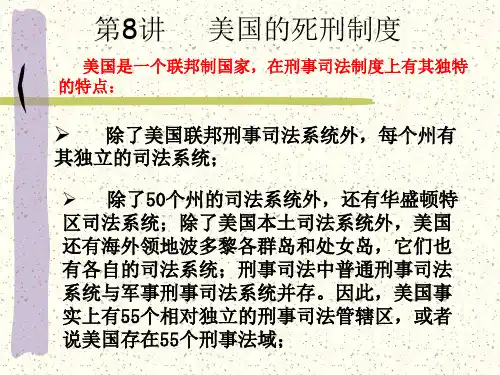
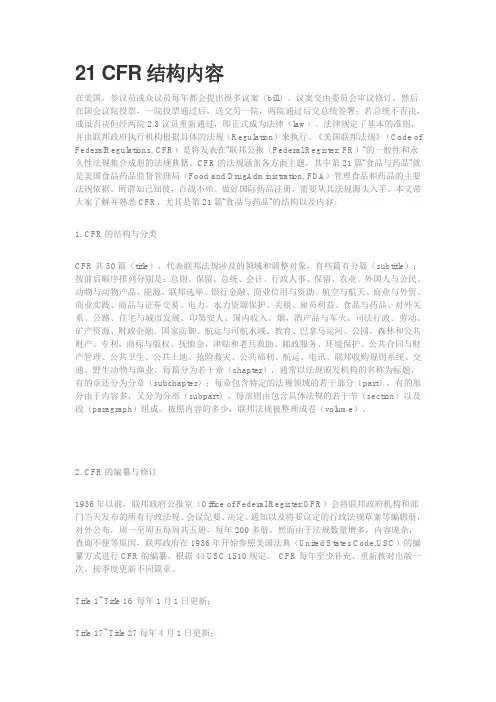
21 CFR结构内容在美国,参议员或众议员每年都会提出很多议案(bill)。
议案交由委员会审议修订,然后在国会议院投票,一院投票通过后,送交另一院,两院通过后交总统签署;若总统不否决,或虽否决但经两院2/3议员重新通过,即正式成为法律(law)。
法律规定了基本的准则,并由联邦政府执行机构根据具体的法规(Regulation)来执行。
《美国联邦法规》(Code of FederalRegulations, CFR)是将发表在“联邦公报(Federal Register, FR)”的一般性和永久性法规集合成册的法规典籍。
CFR的法规涵盖各方面主题,其中第21篇“食品与药品”就是美国食品药品监督管理局(Food and DrugAdministration, FDA)管理食品和药品的主要法规依据。
所谓知己知彼,百战不殆。
做好国际药品注册,需要从其法规源头入手。
本文带大家了解并熟悉CFR,尤其是第21篇“食品与药品”的结构以及内容。
1. CFR的结构与分类CFR共50篇(title),代表联邦法规涉及的领域和调整对象,有些篇有分篇(subtitle);按前后顺序排列分别是:总则、保留、总统、会计、行政人事、保留、农业、外国人与公民、动物与动物产品、能源、联邦选举、银行金融、商业信用与资助、航空与航天、商业与外贸、商业实践、商品与证券交易、电力,水力资源保护、关税、雇员利益、食品与药品、对外关系、公路、住宅与城市发展、印第安人、国内收入、烟,酒产品与军火、司法行政、劳动、矿产资源、财政金融、国家防御、航运与可航水域、教育、巴拿马运河、公园,森林和公共财产、专利,商标与版权、抚恤金,津贴和老兵救助、邮政服务、环境保护、公共合同与财产管理、公共卫生、公共土地、抢险救灾、公共福利、航运、电讯、联邦收购规则系统、交通、野生动物与渔业。
每篇分为若干章(chapter),通常以法规颁发机构的名称为标题,有的章还分为分章(subchapter);每章包含特定的法规领域的若干部分(part),有的部分由于内容多,又分为分部(subpart)。
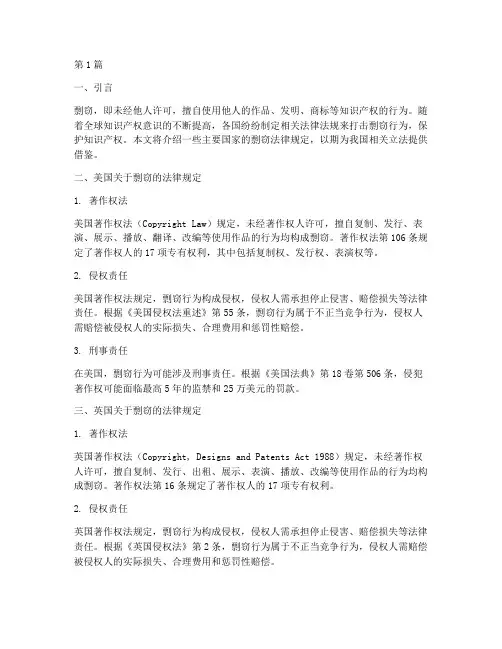
第1篇一、引言剽窃,即未经他人许可,擅自使用他人的作品、发明、商标等知识产权的行为。
随着全球知识产权意识的不断提高,各国纷纷制定相关法律法规来打击剽窃行为,保护知识产权。
本文将介绍一些主要国家的剽窃法律规定,以期为我国相关立法提供借鉴。
二、美国关于剽窃的法律规定1. 著作权法美国著作权法(Copyright Law)规定,未经著作权人许可,擅自复制、发行、表演、展示、播放、翻译、改编等使用作品的行为均构成剽窃。
著作权法第106条规定了著作权人的17项专有权利,其中包括复制权、发行权、表演权等。
2. 侵权责任美国著作权法规定,剽窃行为构成侵权,侵权人需承担停止侵害、赔偿损失等法律责任。
根据《美国侵权法重述》第55条,剽窃行为属于不正当竞争行为,侵权人需赔偿被侵权人的实际损失、合理费用和惩罚性赔偿。
3. 刑事责任在美国,剽窃行为可能涉及刑事责任。
根据《美国法典》第18卷第506条,侵犯著作权可能面临最高5年的监禁和25万美元的罚款。
三、英国关于剽窃的法律规定1. 著作权法英国著作权法(Copyright, Designs and Patents Act 1988)规定,未经著作权人许可,擅自复制、发行、出租、展示、表演、播放、改编等使用作品的行为均构成剽窃。
著作权法第16条规定了著作权人的17项专有权利。
2. 侵权责任英国著作权法规定,剽窃行为构成侵权,侵权人需承担停止侵害、赔偿损失等法律责任。
根据《英国侵权法》第2条,剽窃行为属于不正当竞争行为,侵权人需赔偿被侵权人的实际损失、合理费用和惩罚性赔偿。
3. 刑事责任在英国,剽窃行为可能涉及刑事责任。
根据《英国法典》第279条,侵犯著作权可能面临最高6个月的监禁和5,000英镑的罚款。
四、德国关于剽窃的法律规定1. 著作权法德国著作权法(Urheberrechtsgesetz)规定,未经著作权人许可,擅自复制、发行、出租、展示、表演、播放、改编等使用作品的行为均构成剽窃。
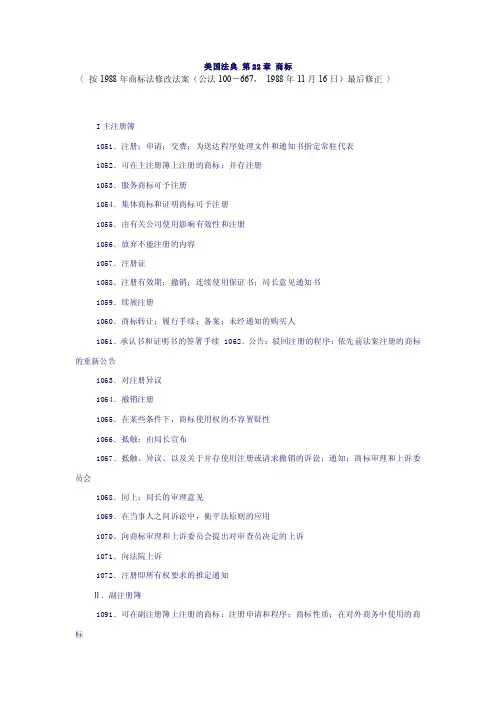
美国法典第22章商标〈按1988年商标法修改法案(公法100-667,1988年11月16日)最后修正〉I主注册簿1051.注册;申请;交费;为送达程序处理文件和通知书指定常驻代表1052.可在主注册簿上注册的商标;并存注册1053.服务商标可予注册1054.集体商标和证明商标可予注册1055.由有关公司使用影响有效性和注册1056.放弃不能注册的内容1057.注册证1058.注册有效期;撤销;连续使用保证书;局长意见通知书1059.续展注册1060.商标转让;履行手续;备案;未经通知的购买人1061.承认书和证明书的签署手续 1062.公告;驳回注册的程序;依先前法案注册的商标的重新公告1063.对注册异议1064.撤销注册1065.在某些条件下,商标使用权的不容置疑性1066.抵触;由局长宣布1067.抵触、异议、以及关于并存使用注册或请求撤销的诉讼;通知;商标审理和上诉委员会1068.同上;局长的审理意见1069.在当事人之间诉讼中,衡平法原则的应用1070.向商标审理和上诉委员会提出对审查员决定的上诉1071.向法院上诉1072.注册即所有权要求的推定通知Ⅱ.副注册簿1091.可在副注册簿上注册的商标;注册申请和程序;商标性质;在对外商务中使用的商标1092.公告;不受异议;撤销1093.主注册簿和副注册簿的商标注册证不同1094.本章可适用于副注册簿上注册的条款1095.不排除在主注册簿上注册1096.在副注册簿上的注册不能用以阻止进口Ⅲ.一般条款1111.注册通告;在商标上展示;在侵权诉讼中追索权益和赔偿1112.商品和服务分类;在多个类别上注册1113.费用1114.补救;侵权;印刷和出版商无知侵权1115.在主注册簿上的注册为商标专用权的证据;辩护 1116.禁令;执行;通知局长1117.对侵犯权利的追索;收益、损害赔偿和诉讼费;律师费1118.销毁侵权物品1119.法院对注册的权力1120.对虚假的或欺骗性的注册所负民事责任1121.联邦法院的管辖权1122.各州、州的机关和州的官员的责任1123.专利商标局内的程序实施规章条例1124.禁止进口带有侵权商标或名称的商品1125.虚假的原产地标记、虚假的描述和淡化1126.国际公约1127.解释和定义;本章目的Ⅰ.主注册簿1051.注册;申请;交费;为送达程序处理文件和通知书指定常驻代表[第1条](a)用于商业的商标的所有人可依本章申请在本法建立的主注册簿上注册其商标:(1)向专利商标局提交--(A)一份申请书,按照局长规定的格式,经由申请人或申请单位的官员签署作证,写明申请人的住址和公民身份、申请人第一次使用该商标的日期、申请人在商业上第一次使用该商标的日期、使用该商标的有关商品和有关此类商品使用该商标的方式,并包括作证人的声明,证明确信其本人或其所代表的公司或机构确系申请注册的商标的所有人,并且该商标确系正在商业中使用,并且据其所知和相信,无他人有权在商业中使用与该商标相同或相似的商标,以致该他人在所述有关商品的使用可能引起混淆、误认或欺骗的情况;倘若是提出并存使用要求的申请,申请人应阐明有关其专用权要求的例外情况,应据其所知说明他人并存使用的情况、现有的并存使用的有关商品、并存使用的领域、每一使用的期限,以及申请人拟注册的商品和领域;(B)该商标的图样;(C)按局长要求的份数提交该商标的使用样品或精确复制品。
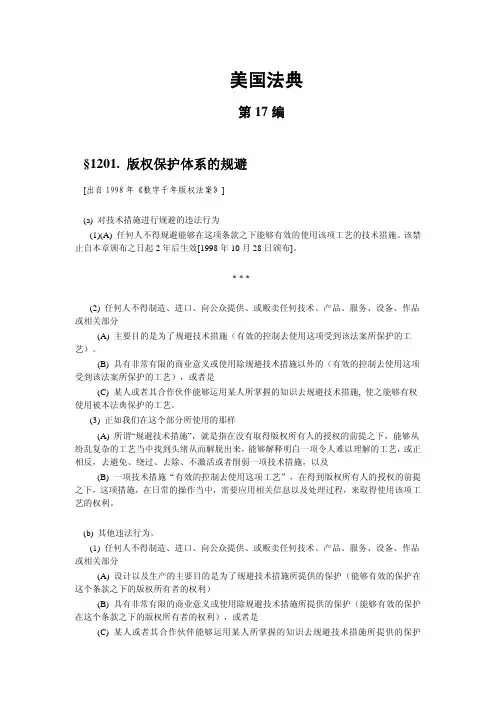
美国法典第17编§1201. 版权保护体系的规避[出自1998年《数字千年版权法案》](a) 对技术措施进行规避的违法行为(1)(A) 任何人不得规避能够在这项条款之下能够有效的使用该项工艺的技术措施。
该禁止自本章颁布之日起2年后生效[1998年10月28日颁布]。
* * *(2) 任何人不得制造、进口、向公众提供、或贩卖任何技术、产品、服务、设备、作品或相关部分——(A) 主要目的是为了规避技术措施(有效的控制去使用这项受到该法案所保护的工艺)。
(B) 具有非常有限的商业意义或使用除规避技术措施以外的(有效的控制去使用这项受到该法案所保护的工艺),或者是(C) 某人或者其合作伙伴能够运用某人所掌握的知识去规避技术措施, 使之能够有权使用被本法典保护的工艺。
(3) 正如我们在这个部分所使用的那样——(A) 所谓“规避技术措施”,就是指在没有取得版权所有人的授权的前提之下,能够从纷乱复杂的工艺当中找到头绪从而解脱出来,能够解释明白一项令人难以理解的工艺,或正相反,去避免、绕过、去除、不激活或者削弱一项技术措施,以及(B) 一项技术措施“有效的控制去使用这项工艺”,在得到版权所有人的授权的前提之下,这项措施,在日常的操作当中,需要应用相关信息以及处理过程,来取得使用该项工艺的权利。
(b) 其他违法行为。
(1) 任何人不得制造、进口、向公众提供、或贩卖任何技术、产品、服务、设备、作品或相关部分——(A) 设计以及生产的主要目的是为了规避技术措施所提供的保护(能够有效的保护在这个条款之下的版权所有者的权利)(B) 具有非常有限的商业意义或使用除规避技术措施所提供的保护(能够有效的保护在这个条款之下的版权所有者的权利),或者是(C) 某人或者其合作伙伴能够运用某人所掌握的知识去规避技术措施所提供的保护(能够有效的保护在这个条款之下的版权所有者的权利)(2) 正如我们在这个部分所使用的那样——(A) 所谓“规避技术措施所提供的保护”,就是指避免,绕过,去除,不激活或者削弱一项技术措施,或者是(B) 一项技术措施“能够有效的保护在这个条款之下的版权所有者的权利”,在日常的操作,预防,限制,或者正相反,限制了在此条款之下版权所有者的权利的实施。

第1篇一、引言家族犯罪,作为一种特殊的犯罪形式,在美国社会中并不鲜见。
家族成员之间的相互依赖、情感纽带以及利益纠葛,往往使得家族犯罪呈现出复杂性和隐蔽性。
在美国,家族犯罪案件的处理受到严格的法律规定和司法实践的影响。
本文将探讨美国法律规定下家族犯罪案件的处理方式,以期对相关法律问题有所了解。
二、美国法律规定概述1. 犯罪定义在美国,犯罪是指违反了联邦或州法律的行为。
根据美国法律,犯罪可分为重罪和轻罪。
重罪包括谋杀、强奸、抢劫等严重犯罪,轻罪则包括盗窃、欺诈等相对较轻的犯罪。
2. 刑罚体系美国刑罚体系主要包括监禁、罚金、缓刑、社区服务等。
对于家族犯罪案件,美国法律规定根据犯罪性质、情节、犯罪人背景等因素,对犯罪分子进行相应的处罚。
3. 证据标准在美国,刑事诉讼的证明标准为“排除合理怀疑”。
这意味着控方必须提供充分的证据,使陪审团或法官确信犯罪嫌疑人的罪行成立。
三、家族犯罪案件的特点1. 复杂性家族犯罪往往涉及多个家庭成员,且成员间关系复杂。
在处理过程中,需要充分考虑家族成员之间的关系、利益纠葛等因素。
2. 隐蔽性家族犯罪案件往往具有隐蔽性,犯罪行为不易被发现。
这使得调查取证和证据固定成为一大难题。
3. 利益纠葛家族犯罪案件中,成员间往往存在利益纠葛。
在处理过程中,需要平衡各方利益,确保司法公正。
四、家族犯罪案件的法律处理1. 调查取证对于家族犯罪案件,调查取证是关键环节。
美国法律规定,警方有权调查、收集证据,包括询问证人、搜查现场等。
2. 审判程序在美国,家族犯罪案件经过调查取证后,进入审判程序。
审判程序包括预审、审判、上诉等阶段。
(1)预审:预审是审判前的初步审查,主要目的是确定案件是否具备审判条件。
(2)审判:审判阶段,法官或陪审团将根据控辩双方提供的证据,对犯罪嫌疑人的罪行进行审理。
(3)上诉:如果当事人对一审判决不服,可以向上级法院提起上诉。
3. 刑罚执行在家族犯罪案件中,根据犯罪性质、情节等因素,法院将对犯罪分子进行相应的处罚。
美国国家安全法全文美国国家安全法(1947年7月26日)本法旨在促进国家安全。
规定了国防部长、国家军事体制、陆军部、海军部和空军部的条款,调整国家军事体制和有关国家安全的政府各部、局的活动。
经美利坚合众国参议院和众议院通过,成为法律。
简短的标题…美国法典第50卷第401章‟本法可称为《1947年国家安全法》目录第2条政策宣言第一章国家安全的协调第101条国家安全的协调第102条中央情报局第103条国家安全资料委员会第二章国防部第201条国防部第202条国防部长第203条国防部长军事助理第204条文职人员第205条陆军部第206条海军部第207条空军部第208条美国空军第209条调动有效日期第210条战争委员会第211条参谋长联席会议第212条联合参谋第213条军火局第214条研究与发展委员会第三章杂项第301条部长薪金第302条次长与助理次长第303条顾问委员会与成员第304条被调文职人员的身份第305条保留条款第306条转帐第307条经费使用的授权第308条定义第309条可分性第310条有效日期第311条总统职务的接续第411条废除与保留条款第五章情报活动的责任第501条国会监督第六章保护某些国家安全的情报第601条美国间谍、情报员及其它来源的秘密情报的保护第602条辩护与例外第603条报告第604条治外法权第605条向国会提供情报第606条定义政策宣言第2条…50美国法典401‟国会制订本法的目的是为美国未来的安全提供一个全面的纲领性文件;确定与国家安全有关的政策和手段的统一体制以及各部、局、政府的职能;设立包括陆军部、海军部(包括海军航空兵和美国海军陆战队)、空军部三个军事部的国防部,并隶属于国防部长的领导、管辖与控制;确立每一个军事部在各部长的领导下成为独立的组织,并在国防部长的领导、管辖和控制下发挥作用;规定上述部门在国防部长的文官控制之下实行统一领导,而不是将这些部门合并;确定统一的体制或明确、直接的战斗方针,国防部长将在研究和设计方面被授予全面的领导权;确定更有效、精干的部门,为各种战斗力量的军事行动制定统一的战略方针,使其结合为更有力的陆、海、空力量,而不是设立一个超越其上的参谋长或参谋总长。
美国法典第42卷公众健康与福利第55章国家环境政策法(1969年制定)第4321条国会的目的宣言本法的目的在于:宣示国家政策,促进人类与环境之间的充分和谐;努力提倡防止或者减少对环境与自然生命物的伤害,增进人类的健康与福利;充分了解生态系统以及自然资源对国家的重要性;设立环境质量委员会。
第4322条至第4330条(原文略)第一节政策与目标第4331条国会国家环境政策宣言鉴于人类活动对自然环境一切构成部分的内在联系具有深远影响,尤其在人口增长、高度集中的都市化、工业发展、资源开发以及技术日益进步所带来的深远影响,并鉴于恢复和保持环境质量对于全人类的福利与发展所具有的重要性,国会特宣布:联邦政府将与各州、地方政府以及有关公共和私人团体合作采取一切切实可行的手段和措施,包括财政和技术上的援助,发展和增进一般福利,创造和保持人类与自然得以共处与和谐中生存的各种条件,满足当代国民及其子孙后代对于社会、经济以及其他方面的要求。
为执行本法规定的政策,联邦政府有责任采取一切切实可行、并与国家政策的其他基本考虑相一致的措施,改进并协调联邦的计划、职能、方案和资源,以达到如下目的,即国家应当:1.履行每一代人都作为子孙后代的环境保管人的责任;2.保证为全体国民创造安全、健康、富有生命力并符合美学和文化上的优美的环境;3. 最大限度地合理利用环境,不得使其恶化或者对健康和安全造成危害,或者引起其他不良的和不应有的后果;4 保护国家历史、文化和自然等方面的重要遗产,并尽可能保持一种能为每个人提供丰富与多样选择的环境;5谋求人口与资源的利用达到平衡,促使国民享受高度的生活水平和广泛舒适的生活;6.提高可更新资源的质量,使易枯竭资源达到最高程度的再循环。
国会认为,每个人都可以享受健康的环境,同时每个人也有责任参与对环境改善与保护。
第4332条机构合作报告;提供资讯;建议;国际与国内的合作国会授权并命令国家机构,应当尽一切可能实现:1.国家的各项政策、法律以及公法解释与执行均应当与本法的规定相一致。
美国法典第17编§1201. 版权保护体系的规避[出自1998年《数字千年版权法案》](a) 对技术措施进行规避的违法行为(1)(A) 任何人不得规避能够在这项条款之下能够有效的使用该项工艺的技术措施。
该禁止自本章颁布之日起2年后生效[1998年10月28日颁布]。
* * *(2) 任何人不得制造、进口、向公众提供、或贩卖任何技术、产品、服务、设备、作品或相关部分——(A) 主要目的是为了规避技术措施(有效的控制去使用这项受到该法案所保护的工艺)。
(B) 具有非常有限的商业意义或使用除规避技术措施以外的(有效的控制去使用这项受到该法案所保护的工艺),或者是(C) 某人或者其合作伙伴能够运用某人所掌握的知识去规避技术措施, 使之能够有权使用被本法典保护的工艺。
(3) 正如我们在这个部分所使用的那样——(A) 所谓“规避技术措施”,就是指在没有取得版权所有人的授权的前提之下,能够从纷乱复杂的工艺当中找到头绪从而解脱出来,能够解释明白一项令人难以理解的工艺,或正相反,去避免、绕过、去除、不激活或者削弱一项技术措施,以及(B) 一项技术措施“有效的控制去使用这项工艺”,在得到版权所有人的授权的前提之下,这项措施,在日常的操作当中,需要应用相关信息以及处理过程,来取得使用该项工艺的权利。
(b) 其他违法行为。
(1) 任何人不得制造、进口、向公众提供、或贩卖任何技术、产品、服务、设备、作品或相关部分——(A) 设计以及生产的主要目的是为了规避技术措施所提供的保护(能够有效的保护在这个条款之下的版权所有者的权利)(B) 具有非常有限的商业意义或使用除规避技术措施所提供的保护(能够有效的保护在这个条款之下的版权所有者的权利),或者是(C) 某人或者其合作伙伴能够运用某人所掌握的知识去规避技术措施所提供的保护(能够有效的保护在这个条款之下的版权所有者的权利)(2) 正如我们在这个部分所使用的那样——(A) 所谓“规避技术措施所提供的保护”,就是指避免,绕过,去除,不激活或者削弱一项技术措施,或者是(B) 一项技术措施“能够有效的保护在这个条款之下的版权所有者的权利”,在日常的操作,预防,限制,或者正相反,限制了在此条款之下版权所有者的权利的实施。
US CODE: TITLE 35—PATENTSPART I—UNITED STATES PATENT AND TRADEMARK OFFICE (§§ 1—42)CHAPTER 1—ESTABLISHMENT, OFFICERS AND EMPLOYEES, FUNCTIONS (§§1—14)CHAPTER 2—PROCEEDINGS IN THE PATENT AND TRADEMARK OFFICE (§§ 21—26)CHAPTER 3—PRACTICE BEFORE PATENT AND TRADEMARK OFFICE (§§ 31—33) CHAPTER 4—PATENT FEES; FUNDING; SEARCH SYSTEMS (§§ 41—42)PART II—PATENTABILITY OF INVENTIONS AND GRANT OF PATENTS (§§ 100—212) CHAPTER 10—PATENTABILITY OF INVENTIONS (§§ 100—105)CHAPTER 11—APPLICATION FOR PATENT (§§ 111—122)CHAPTER 12—EXAMINATION OF APPLICATION (§§ 131—135)CHAPTER 13—REVIEW OF PATENT AND TRADEMARK OFFICE DECISIONS (§§ 141—146)CHAPTER 14—ISSUE OF PATENT (§§ 151—157)CHAPTER 15—PLANT PATENTS (§§ 161—164)CHAPTER 16—DESIGNS (§§ 171—173)CHAPTER 17—SECRECY OF CERTAIN INVENTIONS AND FILING APPLICATIONS IN FOREIGN COUNTRY (§§ 181—188)CHAPTER 18—PATENT RIGHTS IN INVENTIONS MADE WITH FEDERAL ASSISTANCE (§§ 200—212)PART III—PATENTS AND PROTECTION OF PATENT RIGHTS (§§ 251—318) CHAPTER 25—AMENDMENT AND CORRECTION OF PATENTS (§§ 251—256) CHAPTER 26—OWNERSHIP AND ASSIGNMENT (§§ 261—262)CHAPTER 27—GOVERNMENT INTERESTS IN PATENTS (§§ 266—267)CHAPTER 28—INFRINGEMENT OF PATENTS (§§ 271—273)CHAPTER 29—REMEDIES FOR INFRINGEMENT OF PATENT, AND OTHER ACTIONS (§§ 281—297)CHAPTER 30—PRIOR ART CITATIONS TO OFFICE AND EX PARTE REEXAMINATION OF PATENTS (§§ 301—307)CHAPTER 31—OPTIONAL INTER PARTES REEXAMINATION PROCEDURES (§§ 311—318)PART IV—PATENT COOPERATION TREATY (§§ 351—)CHAPTER 35—DEFINITIONS (§ 351)CHAPTER 36—INTERNATIONAL STAGE (§§ 361—368)CHAPTER 37—NATIONAL STAGE (§§ 371—376)[CHAPTER 38—TRANSFERRED]PART I—UNITED STATES PATENT AND TRADEMARK OFFICE (§§ 1—42)CHAPTER 1—ESTABLISHMENT, OFFICERS AND EMPLOYEES, FUNCTIONS (§§ 1—14)§ 1. Establishment(a) Establishment.— The United States Patent and Trademark Office is established as an agency of the United States, within the Department of Commerce. In carrying out its functions, the United States Patent and Trademark Office shall be subject to the policy direction of the Secretary of Commerce, but otherwise shall retain responsibility for decisions regarding the management and administration of its operations and shall exercise independent control of its budget allocations and expenditures, personnel decisions and processes, procurements, and other administrative and management functions in accordance with this title and applicable provisions of law. Those operations designed to grant and issue patents and those operations which are designed to facilitate the registration of trademarks shall be treated as separate operating units within the Office.(b) Offices.— The United States Patent and Trademark Office shall maintain its principal office in the metropolitan Washington, D.C., area, for the service of process and papers and for the purpose of carrying out its functions. The United States Patent and Trademark Office shall be deemed, for purposes of venue in civil actions, to be a resident of the district in which its principal office is located, except where jurisdiction is otherwise provided by law. The United States Patent and Trademark Office may establish satellite offices in such other places in the United States as it considers necessary and appropriate in the conduct of its business.(c) Reference.— For purposes of this title, the United States Patent and Trademark Office shall also be referred to as the “Office” and the “Patent and Trademark Office”.§ 2. Powers and duties(a) In General.— The United States Patent and Trademark Office, subject to the policy direction of the Secretary of Commerce—(1) shall be responsible for the granting and issuing of patents and the registration of trademarks; and(2) shall be responsible for disseminating to the public information with respect to patents and trademarks.(b) Specific Powers.— The Office—(1) shall adopt and use a seal of the Office, which shall be judicially noticed and with which letters patent, certificates of trademark registrations, and papers issued by the Office shall be authenticated;(2) may establish regulations, not inconsistent with law, which—(A) shall govern the conduct of proceedings in the Office;(B) shall be made in accordance with section 553 of title 5;(C) shall facilitate and expedite the processing of patent applications, particularly those which can be filed, stored, processed, searched, and retrieved electronically, subject to the provisions of section 122 relating to the confidential status of applications;(D) may govern the recognition and conduct of agents, attorneys, or other persons representing applicants or other parties before the Office, and may require them, before being recognized as representatives of applicants or other persons, to show that they are of good moral character and reputation and are possessed of the necessary qualifications to render to applicants or other persons valuable service, advice, and assistance in the presentation or prosecution of their applications or other business before the Office;(E) shall recognize the public interest in continuing to safeguard broad access to the United States patent system through the reduced fee structure for small entities under section 41 (h)(1) of this title; and(F) provide for the development of a performance-based process that includes quantitative and qualitative measures and standards for evaluating cost-effectiveness and is consistent with the principles of impartiality and competitiveness;(3) may acquire, construct, purchase, lease, hold, manage, operate, improve, alter, and renovate any real, personal, or mixed property, or any interest therein, as it considers necessary to carry out its functions;(4) (A) may make such purchases, contracts for the construction, maintenance, or management and operation of facilities, and contracts for supplies or services, without regard to the provisions of subtitle I and chapter 33 of title 40, title III of the Federal Property and Administrative Services Act of 1949 (41 U.S.C. 251 et seq.), and the McKinney-Vento Homeless Assistance Act (42 U.S.C. 11301 et seq.); and(B) may enter into and perform such purchases and contracts for printing services, including the process of composition, platemaking, presswork, silk screen processes, binding, microform, and the products of such processes, as it considers necessary to carry out the functions of the Office, without regard to sections 501 through 517 and 1101 through 1123 of title 44;(5) may use, with their consent, services, equipment, personnel, and facilities of other departments, agencies, and instrumentalities of the Federal Government, on a reimbursable basis, and cooperate with such other departments, agencies, and instrumentalities in the establishment and use of services, equipment, and facilities of the Office;(6) may, when the Director determines that it is practicable, efficient, and cost-effective to do so, use, with the consent of the United States and the agency, instrumentality, Patent and Trademark Office, or international organization concerned, the services, records, facilities, or personnel of any State or local government agency or instrumentality or foreign patent and trademark office or international organization to perform functions on its behalf;(7) may retain and use all of its revenues and receipts, including revenues from the sale, lease, or disposal of any real, personal, or mixed property, or any interest therein, of the Office;(8) shall advise the President, through the Secretary of Commerce, on national and certain international intellectual property policy issues;(9) shall advise Federal departments and agencies on matters of intellectual property policy in the United States and intellectual property protection in other countries;(10) shall provide guidance, as appropriate, with respect to proposals by agencies to assist foreign governments and international intergovernmental organizations on matters of intellectual propertyprotection;(11) may conduct programs, studies, or exchanges of items or services regarding domestic and international intellectual property law and the effectiveness of intellectual property protection domestically and throughout the world;(12) (A) shall advise the Secretary of Commerce on programs and studies relating to intellectual property policy that are conducted, or authorized to be conducted, cooperatively with foreign intellectual property offices and international intergovernmental organizations; and(B) may conduct programs and studies described in subparagraph (A); and(13) (A) in coordination with the Department of State, may conduct programs and studies cooperatively with foreign intellectual property offices and international intergovernmental organizations; and(B) with the concurrence of the Secretary of State, may authorize the transfer of not to exceed $100,000 in any year to the Department of State for the purpose of making special payments to international intergovernmental organizations for studies and programs for advancing international cooperation concerning patents, trademarks, and other matters.(c) Clarification of Specific Powers.—(1) The special payments under subsection (b)(13)(B) shall be in addition to any other payments or contributions to international organizations described in subsection (b)(13)(B) and shall not be subject to any limitations imposed by law on the amounts of such other payments or contributions by the United States Government.(2) Nothing in subsection (b) shall derogate from the duties of the Secretary of State or from the duties of the United States Trade Representative as set forth in section 141 of the Trade Act of 1974 (19 U.S.C. 2171).(3) Nothing in subsection (b) shall derogate from the duties and functions of the Register of Copyrights or otherwise alter current authorities relating to copyright matters.(4) In exercising the Director’s powers under paragraphs (3) and (4)(A) of subsection (b), the Director shall consult with the Administrator of General Services.(5) In exercising the Director’s powers and duties under this section, the Director shall consult with the Register of Copyrights on all copyright and related matters.(d) Construction.— Nothing in this section shall be construed to nullify, void, cancel, or interrupt any pending request-for-proposal let or contract issued by the General Services Administration for the specific purpose of relocating or leasing space to the United States Patent and Trademark Office.§ 3. Officers and employees(a) Under Secretary and Director.—(1) In general.— The powers and duties of the United States Patent and Trademark Office shall be vested in an Under Secretary of Commerce for Intellectual Property and Director of the United States Patent and Trademark Office (in this title referred to as the “Director”), who shall be a citizen of the United States and who shall be appointed by the President, by and with the advice and consent of the Senate. The Director shall be a person who has a professional background andexperience in patent or trademark law.(2) Duties.—(A) In general.— The Director shall be responsible for providing policy direction and management supervision for the Office and for the issuance of patents and the registration of trademarks. The Director shall perform these duties in a fair, impartial, and equitable manner. (B) Consulting with the public advisory committees.— The Director shall consult with the Patent Public Advisory Committee established in section 5 on a regular basis on matters relating to the patent operations of the Office, shall consult with the Trademark Public Advisory Committee established in section 5 on a regular basis on matters relating to the trademark operations of the Office, and shall consult with the respective Public Advisory Committee before submitting budgetary proposals to the Office of Management and Budget or changing or proposing to change patent or trademark user fees or patent or trademark regulations which are subject to the requirement to provide notice and opportunity for public comment under section 553 of title 5, as the case may be.(3) Oath.— The Director shall, before taking office, take an oath to discharge faithfully the duties of the Office.(4) Removal.— The Director may be removed from office by the President. The President shall provide notification of any such removal to both Houses of Congress.(b) Officers and Employees of the Office.—(1) Deputy under secretary and deputy director.— The Secretary of Commerce, upon nomination by the Director, shall appoint a Deputy Under Secretary of Commerce for Intellectual Property and Deputy Director of the United States Patent and Trademark Office who shall be vested with the authority to act in the capacity of the Director in the event of the absence or incapacity of the Director. The Deputy Director shall be a citizen of the United States who has a professional background and experience in patent or trademark law.(2) Commissioners.—(A) Appointment and duties.— The Secretary of Commerce shall appoint a Commissioner for Patents and a Commissioner for Trademarks, without regard to chapter 33, 51, or 53 of title 5. The Commissioner for Patents shall be a citizen of the United States with demonstrated management ability and professional background and experience in patent law and serve for a term of 5 years. The Commissioner for Trademarks shall be a citizen of the United States with demonstrated management ability and professional background and experience in trademark law and serve for a term of 5 years. The Commissioner for Patents and the Commissioner for Trademarks shall serve as the chief operating officers for the operations of the Office relating to patents and trademarks, respectively, and shall be responsible for the management and direction of all aspects of the activities of the Office that affect the administration of patent and trademark operations, respectively. The Secretary may reappoint a Commissioner to subsequent terms of 5 years as long as the performance of the Commissioner as set forth in the performance agreement in subparagraph (B) is satisfactory.(B) Salary and performance agreement.— The Commissioners shall be paid an annual rate of basic pay not to exceed the maximum rate of basic pay for the Senior Executive Service established under section 5382 of title 5, including any applicable locality-based comparability payment that may be authorized under section 5304 (h)(2)(C) of title 5. The compensation of theCommissioners shall be considered, for purposes of section 207 (c)(2)(A) of title 18, to be the equivalent of that described under clause (ii) of section 207 (c)(2)(A) of title 18. In addition, the Commissioners may receive a bonus in an amount of up to, but not in excess of, 50 percent of the Commissioners’ annual rate of basic pay, based upon an evaluation by the Secretary of Commerce, acting through the Director, of the Commissioners’ performance as defined in an annual performance agreement between the Commissioners and the Secretary. The annual performance agreements shall incorporate measurable organization and individual goals in key operational areas as delineated in an annual performance plan agreed to by the Commissioners and the Secretary. Payment of a bonus under this subparagraph may be made to the Commissioners only to the extent that such payment does not cause the Commissioners’ total aggregate compensation in a calendar year to equal or exceed the amount of the salary of the Vice President under section 104 of title 3.(C) Removal.— The Commissioners may be removed from office by the Secretary for misconduct or nonsatisfactory performance under the performance agreement described in subparagraph (B), without regard to the provisions of title 5. The Secretary shall provide notification of any such removal to both Houses of Congress.(3) Other officers and employees.— The Director shall—(A) appoint such officers, employees (including attorneys), and agents of the Office as the Director considers necessary to carry out the functions of the Office; and(B) define the title, authority, and duties of such officers and employees and delegate to them such of the powers vested in the Office as the Director may determine.The Office shall not be subject to any administratively or statutorily imposed limitation on positions or personnel, and no positions or personnel of the Office shall be taken into account for purposes of applying any such limitation.(4) Training of examiners.— The Office shall submit to the Congress a proposal to provide an incentive program to retain as employees patent and trademark examiners of the primary examiner grade or higher who are eligible for retirement, for the sole purpose of training patent and trademark examiners.(5) National security positions.— The Director, in consultation with the Director of the Office of Personnel Management, shall maintain a program for identifying national security positions and providing for appropriate security clearances, in order to maintain the secrecy of certain inventions, as described in section 181, and to prevent disclosure of sensitive and strategic information in the interest of national security.(c) Continued Applicability of Title 5.— Officers and employees of the Office shall be subject to the provisions of title 5, relating to Federal employees.(d) Adoption of Existing Labor Agreements.— The Office shall adopt all labor agreements which are in effect, as of the day before the effective date of the Patent and Trademark Office Efficiency Act, with respect to such Office (as then in effect).(e) Carryover of Personnel.—(1) From pto.— Effective as of the effective date of the Patent and Trademark Office Efficiency Act, all officers and employees of the Patent and Trademark Office on the day before sucheffective date shall become officers and employees of the Office, without a break in service.(2) Other personnel.— Any individual who, on the day before the effective date of the Patent and Trademark Office Efficiency Act, is an officer or employee of the Department of Commerce (other than an officer or employee under paragraph (1)) shall be transferred to the Office, as necessary to carry out the purposes of this Act,[1] if—(A) such individual serves in a position for which a major function is the performance of work reimbursed by the Patent and Trademark Office, as determined by the Secretary of Commerce; (B) such individual serves in a position that performed work in support of the Patent and Trademark Office during at least half of the incumbent’s work time, as determined by the Secretary of Commerce; or(C) such transfer would be in the interest of the Office, as determined by the Secretary of Commerce in consultation with the Director.Any transfer under this paragraph shall be effective as of the same effective date as referred to in paragraph (1), and shall be made without a break in service.(f) Transition Provisions.—(1) Interim appointment of director.— On or after the effective date of the Patent and Trademark Office Efficiency Act, the President shall appoint an individual to serve as the Director until the date on which a Director qualifies under subsection (a). The President shall not make more than one such appointment under this subsection.(2) Continuation in office of certain officers.—(A) The individual serving as the Assistant Commissioner for Patents on the day before the effective date of the Patent and Trademark Office Efficiency Act may serve as the Commissioner for Patents until the date on which a Commissioner for Patents is appointed under subsection (b).(B) The individual serving as the Assistant Commissioner for Trademarks on the day before the effective date of the Patent and Trademark Office Efficiency Act may serve as the Commissioner for Trademarks until the date on which a Commissioner for Trademarks is appointed under subsection (b).§ 4. Restrictions on officers and employees as to interest in patentsOfficers and employees of the Patent and Trademark Office shall be incapable, during the period of their appointments and for one year thereafter, of applying for a patent and of acquiring, directly or indirectly, except by inheritance or bequest, any patent or any right or interest in any patent, issued or to be issued by the Office. In patents applied for thereafter they shall not be entitled to any priority date earlier than one year after the termination of their appointment.§ 5. Patent and Trademark Office Public Advisory Committees(a) Establishment of Public Advisory Committees.—(1) Appointment.— The United States Patent and Trademark Office shall have a Patent Public Advisory Committee and a Trademark Public Advisory Committee, each of which shall have nine voting members who shall be appointed by the Secretary of Commerce and serve at the pleasure of the Secretary of Commerce. Members of each Public Advisory Committee shall be appointedfor a term of 3 years, except that of the members first appointed, three shall be appointed for a term of 1 year, and three shall be appointed for a term of 2 years. In making appointments to each Committee, the Secretary of Commerce shall consider the risk of loss of competitive advantage in international commerce or other harm to United States companies as a result of such appointments.(2) Chair.— The Secretary shall designate a chair of each Advisory Committee, whose term as chair shall be for 3 years.(3) Timing of appointments.— Initial appointments to each Advisory Committee shall be made within 3 months after the effective date of the Patent and Trademark Office Efficiency Act. Vacancies shall be filled within 3 months after they occur.(b) Basis for Appointments.— Members of each Advisory Committee—(1) shall be citizens of the United States who shall be chosen so as to represent the interests of diverse users of the United States Patent and Trademark Office with respect to patents, in the case of the Patent Public Advisory Committee, and with respect to trademarks, in the case of the Trademark Public Advisory Committee;(2) shall include members who represent small and large entity applicants located in the United States in proportion to the number of applications filed by such applicants, but in no case shall members who represent small entity patent applicants, including small business concerns, independent inventors, and nonprofit organizations, constitute less than 25 percent of the members of the Patent Public Advisory Committee, and such members shall include at least one independent inventor; and(3) shall include individuals with substantial background and achievement in finance, management, labor relations, science, technology, and office automation. In addition to the voting members, each Advisory Committee shall include a representative of each labor organization recognized by the United States Patent and Trademark Office. Such representatives shall be nonvoting members of the Advisory Committee to which they are appointed.(c) Meetings.— Each Advisory Committee shall meet at the call of the chair to consider an agenda set by the chair.(d) Duties.— Each Advisory Committee shall—(1) review the policies, goals, performance, budget, and user fees of the United States Patent and Trademark Office with respect to patents, in the case of the Patent Public Advisory Committee, and with respect to Trademarks, in the case of the Trademark Public Advisory Committee, and advise the Director on these matters;(2) within 60 days after the end of each fiscal year—(A) prepare an annual report on the matters referred to in paragraph (1);(B) transmit the report to the Secretary of Commerce, the President, and the Committees on the Judiciary of the Senate and the House of Representatives; and(C) publish the report in the Official Gazette of the United States Patent and Trademark Office.(e) Compensation.— Each member of each Advisory Committee shall be compensated for each day (including travel time) during which such member is attending meetings or conferences of thatAdvisory Committee or otherwise engaged in the business of that Advisory Committee, at the rate which is the daily equivalent of the annual rate of basic pay in effect for level III of the Executive Schedule under section 5314 of title 5. While away from such member’s home or regular place of business such member shall be allowed travel expenses, including per diem in lieu of subsistence, as authorized by section 5703 of title 5.(f) Access to Information.— Members of each Advisory Committee shall be provided access to records and information in the United States Patent and Trademark Office, except for personnel or other privileged information and information concerning patent applications required to be kept in confidence by section 122.(g) Applicability of Certain Ethics Laws.— Members of each Advisory Committee shall be special Government employees within the meaning of section 202 of title 18.(h) Inapplicability of Federal Advisory Committee Act.— The Federal Advisory Committee Act (5 U.S.C. App.) shall not apply to each Advisory Committee.(i) Open Meetings.— The meetings of each Advisory Committee shall be open to the public, except that each Advisory Committee may by majority vote meet in executive session when considering personnel, privileged, or other confidential information.(j) Inapplicability of Patent Prohibition.— Section 4 shall not apply to voting members of the Advisory Committees.§ 6. Board of Patent Appeals and Interferences(a) Establishment and Composition.— There shall be in the United States Patent and Trademark Office a Board of Patent Appeals and Interferences. The Director, the Deputy Director, the Commissioner for Patents, the Commissioner for Trademarks, and the administrative patent judges shall constitute the Board. The administrative patent judges shall be persons of competent legal knowledge and scientific ability who are appointed by the Secretary of Commerce, in consultation with the Director.(b) Duties.— The Board of Patent Appeals and Interferences shall, on written appeal of an applicant, review adverse decisions of examiners upon applications for patents and shall determine priority and patentability of invention in interferences declared under section 135 (a). Each appeal and interference shall be heard by at least three members of the Board, who shall be designated by the Director. Only the Board of Patent Appeals and Interferences may grant rehearings.(c) Authority of the Secretary.— The Secretary of Commerce may, in his or her discretion, deem the appointment of an administrative patent judge who, before the date of the enactment of this subsection, held office pursuant to an appointment by the Director to take effect on the date on which the Director initially appointed the administrative patent judge.(d) Defense to Challenge of Appointment.— It shall be a defense to a challenge to the appointment of an administrative patent judge on the basis of the judge’s having been originally appointed by the Director that the administrative patent judge so appointed was acting as a de facto officer.§ 7. LibraryThe Director shall maintain a library of scientific and other works and periodicals, both foreign and domestic, in the Patent and Trademark Office to aid the officers in the discharge of their duties.§8. Classification of patentsThe Director may revise and maintain the classification by subject matter of United States letters patent, and such other patents and printed publications as may be necessary or practicable, for the purpose of determining with readiness and accuracy the novelty of inventions for which applications for patent are filed.§9. Certified copies of recordsThe Director may furnish certified copies of specifications and drawings of patents issued by the Patent and Trademark Office, and of other records available either to the public or to the person applying therefor.§ 10. Publications(a) The Director may publish in printed, typewritten, or electronic form, the following:1. Patents and published applications for patents, including specifications and drawings, together with copies of the same. The Patent and Trademark Office may print the headings of the drawings for patents for the purpose of photolithography.2. Certificates of trade-mark registrations, including statements and drawings, together with copies of the same.3. The Official Gazette of the United States Patent and Trademark Office.4. Annual indexes of patents and patentees, and of trade-marks and registrants.5. Annual volumes of decisions in patent and trade-mark cases.6. Pamphlet copies of the patent laws and rules of practice, laws and rules relating to trade-marks, and circulars or other publications relating to the business of the Office.(b) The Director may exchange any of the publications specified in items 3, 4, 5, and 6 of subsection (a) of this section for publications desirable for the use of the Patent and Trademark Office.§11. Exchange of copies of patents and applications with foreign countries。
一、美国《雷斯法案》简介《雷斯法案》(《美国法典》第16 卷第3371 至3378 节),是美国第一部联邦自然保护法案。
在19 世纪与20 世纪之交,以营利为目的的非法捕猎在美国尤其是西南部泛滥,严重威胁了美国诸多野生物种。
1900 年春天,爱荷华州的共和党人约翰雷斯(John F. Lacey)议员向美国国会提交了《雷斯法案》提案。
规定依据各州法律,禁止在各州之间运输非法捕猎物或者受保护动物。
同年5 月25 日,美国总统威廉.麦金莱(William McKinley)签署通过《雷斯法案》。
生效之后,作为美国联邦层面的第一部环境保护法律,《雷斯法案》百余年来历经修订,最为重要的有1969 年、1981 年、1989 年和2008 年的几次修订。
经过多次完善,《雷斯法案》内容不断演化,适用领域日益广泛,时至今日,已构成美国联邦野生动植物资源保护执法体系的基础。
美国《雷斯法案》只是2007 年美国粮食、保护和能源法案(俗称“美国农业法案”)的一部分,一直以来是美国相关机构打击野生动物犯罪最有力的工具之一。
于2008 年5 月22 日正式生效的美国《雷斯法案修正案》延伸至植物及其制品(林产品)贸易,它认可、支持其他国家管理本国自然资源中做出的努力,并对企业交易来自合法渠道的植物及植物制品(林产品)提供强有力的法律保障。
通俗地说,如果“你”在植物的获取、采伐、占有、运输、销售或出口环节违反了任何一个国家或美国各州的相关法律,以及提供虚假证明、虚假商标等等,那么根据雷斯法案“你”已经违反美国法律《雷斯法案修正案》。
例如,“你”在A 国砍伐、运输木材违反了A 国政府的相关法律(如:非法采伐或者没有交纳相关税费),或者你在中国使用这批木材加工成地板或者家具再出口到美国,只要你的这批木材制品跟地理概念上的“美国”发生关系时,就触犯了《雷斯法案修正案》。
美国政府就会因为“你”从采伐到交易过程中违反了所在国的法律而判“你”违法。
美国法典第42卷公众健康与福利第55章国家环境政策法(1969年制定)第4321条国会的目的宣言本法的目的在于:宣示国家政策,促进人类与环境之间的充分和谐;努力提倡防止或者减少对环境与自然生命物的伤害,增进人类的健康与福利;充分了解生态系统以及自然资源对国家的重要性;设立环境质量委员会。
第4322条至第4330条(原文略)第一节政策与目标第4331条国会国家环境政策宣言鉴于人类活动对自然环境一切构成部分的内在联系具有深远影响,尤其在人口增长、高度集中的都市化、工业发展、资源开发以及技术日益进步所带来的深远影响,并鉴于恢复和保持环境质量对于全人类的福利与发展所具有的重要性,国会特宣布:联邦政府将与各州、地方政府以及有关公共和私人团体合作采取一切切实可行的手段和措施,包括财政和技术上的援助,发展和增进一般福利,创造和保持人类与自然得以共处与和谐中生存的各种条件,满足当代国民及其子孙后代对于社会、经济以及其他方面的要求。
为执行本法规定的政策,联邦政府有责任采取一切切实可行、并与国家政策的其他基本考虑相一致的措施,改进并协调联邦的计划、职能、方案和资源,以达到如下目的,即国家应当:1.履行每一代人都作为子孙后代的环境保管人的责任;2.保证为全体国民创造安全、健康、富有生命力并符合美学和文化上的优美的环境;3. 最大限度地合理利用环境,不得使其恶化或者对健康和安全造成危害,或者引起其他不良的和不应有的后果;4 保护国家历史、文化和自然等方面的重要遗产,并尽可能保持一种能为每个人提供丰富与多样选择的环境;5谋求人口与资源的利用达到平衡,促使国民享受高度的生活水平和广泛舒适的生活;6.提高可更新资源的质量,使易枯竭资源达到最高程度的再循环。
国会认为,每个人都可以享受健康的环境,同时每个人也有责任参与对环境改善与保护。
第4332条机构合作报告;提供资讯;建议;国际与国内的合作国会授权并命令国家机构,应当尽一切可能实现:1.国家的各项政策、法律以及公法解释与执行均应当与本法的规定相一致。
2.所有联邦政府的机关均应当:(1)在进行可能对人类环境产生影响的规划和决定时,应当采用足以确保综合利用自然科学、社会科学以及环境设计工艺的系统性和多学科的方法。
(2)与依本法第二节规定而设立的环境质量委员会进行磋商,确定并开发各种方法与程序,确保在做出决定时使得当前尚不符合要求的环境舒适和环境价值。
能与经济和技术问题一并得到适当的考虑。
(3)对人类环境质量具有重大影响的各项提案或法律草案、建议报告以及其他重大联邦行为,均应当由负责经办的官员提供一份包括下列事项的详细说明:①拟议行为对环境的影响;②提案行为付诸实施对环境所产生的不可避免的不良影响;③提案行为的各种替代方案;④对人类环境的区域性短期使用与维持和加强长期生命力之间的关系;⑤提案行为付诸实施时可能产生的无法恢复和无法补救的资源耗损。
在制作详细说明之前,联邦负责经办的官员应当与依法享有管辖权或者具有特殊专门知识的任何联邦机关进行磋商,并取得他们对可能引起的任何环境影响所做的评价。
该说明评价应当与负责制定和执行环境标准所相应的联邦、州以及地方机构所做的评价和意见书的副本一并提交总统与环境质量委员会,并依照美国法典第五章第552条的规定向公众公开。
这些文件应当与提案一道依现行机构审查办法的规定审查通过。
(4)1970年1月1日以后,在州补助金计划资助下的任何联邦重大行为,因下列情形而由州机构或者官员准备执行的,亦应当依第3目的规定提供详细的说明书:①由州机构或者其官员作为责任者对全州的此类行为享有管辖权的;②由经办联邦官员提供指导并参与准备工作的;③在核准与采用前,由经办联邦官员独立评价说明书的;④在1976年1月1日以后,对其他州或联邦土地管理的实际行为或者可能对州或联邦土地管理产生重大影响的替代方案,联邦经办官员应当提出初步通知书并要求其提出意见。
对这类行为的影响有不同意见的,应当准备有关书面的影响评价与意见书,并编入详细说明书内。
执行本项所规定的程序并不减轻联邦官员对整个说明书范围、目标、内容以及本节的任何责任,即本项规定不影响由州政府机构制定缺乏全州性管辖权的说明的合法性。
(5)研究、制定并阐述适当的替代方案,并推荐给那些有关选择利用现有资源但至今尚在激烈争论的提案。
(6)确认环境问题具有世界性和长远性的特点,并与美国的外交政策相一致,为预防和阻止人类世界的环境质量衰退而倡议、决议扩大国际合作,并计划对国际合作给予适当的支持。
(7)对各州、县、市、机关团体与个人提供关于有益于恢复、保持和改善环境质量的建议与资讯。
(8)在制定和开展资源开发的计划中提倡和使用生态学资讯。
(9)协助依照本法第二节规定而建立的环境质量委员会的工作。
第4333条与国家环境政策一致的行政程序所有联邦政府机构均应当对其现有的法定职权、行政法规定以及各项现行政策和程序进行一次清理,以确定其是否存在有妨害充分执行本法宗旨和规定的任何缺陷或矛盾,并应当就清理结果在不迟于1971年7月1日以前,向总统报告其职权和各项政策符合本法所规定的意图、宗旨和程序。
第4334条联邦机构的其他法定义务第4332条或者第4333条的规定,不得以任何方式影响联邦机构下列具体法定义务;1.遵守环境质量的规范或标准;2、与其他联邦或州机构相协调或进行商量;3.根据其他联邦或州机构的建议或证明,采取或禁止采取行动。
第4335条对现行职权的补充本法所规定的政策与目标,性质上属于对联邦各机构现行职权的补充。
第4336条至4340条(原文略)第二节环境质量委员会第4341条向国会报告;立法建议总统应当自1970年7月1日起,每年度向国会提交环境质量报告(以下简称报告),其中应当说明:1国家各种主要的自然、人为或改造过的环境的状况与情况,包括但不限于空气、水(包括海域、海湾及淡水)以及陆地环境(包括但不限于森林、干地、湿地、山脉、城市、郊区及乡村环境);2前项规定的环境质量、管理与使用,在当前与未来的发展趋势,以及这种趋势对国家的社会、经济与其他需要的影响;3.按照人口压力的预计,说明可利用的自然资源能否满足国民生活与经济需要;4对联邦政府、州与地方政府以及非政府性质的机关或个人的计划与活动(包括常规活动)的评价,并着重说明其对环境以及自然资源的保护、发展与利用的影响;5.对各种现有计划与活动的缺陷提出补救方案和立法建议。
第4342条设立;成员;主席;任命总统府设立环境质量委员会(以下简称委员会)。
该委员会由三人组成。
人选经总统提名,在征得参议院同意后任命,在总统指挥下工作。
总统应当指定其中一人担任委员会主席。
每个委员都应当具有相应的训练、经验和造诣,有能力分析和解释各种环境发展趋势和信息;按照本章第4331条规定的政策对联邦政府的计划和活动进行评价;对国家的科学、经济、社会、美学与文化等方面的需要和利益具有清晰的认识和责任感,并能就促进环境质量的改善提出各项国家政策。
第4343条人员、专家与顾问的聘用委员会可以聘用执行本法规定有关职能所需的官员和职员。
委员会也可以依照美国法典第五章第3109条(但不适用该条最后一段)的规定,聘用为执行本法所规定的职能所必需的专家和顾问,并对其津贴支领办法作出规定。
依照美国法典第31章第1342条规定,委员会可以聘用和接受自愿提供服务人员,以实现委员会的目的。
第4344条责任与职能委员会具有以下责任和职能:1.在总统依照本节第4341条制作环境质量报告时,提供帮助和建议。
2.适时收集关于当前和未来环境质量的状况以及发展趋势的正确资讯,并对该资讯进行分析和解释,以确定这种状况与发展趋势是否妨碍本节第4341条所规定政策的贯彻执行。
编辑关于此项情况与发展趋势的研究报告,并向总统提出建议。
3.按照本章第一节所规定的政策,对联邦政府的各项计划和活动进行审查和评价,以确定这些计划和活动有助于该政策贯彻执行的程度,并就此向总统提出建议。
4.研究促进环境质量的改善问题,并向总统提出各项国家政策的建议,以达到环境保护和国家社会、经济、卫生及其他方面的需要与目的。
5.对生态系统与环境质量进行调查、研究、考察、探讨与分析。
6.记录并确定自然环境的变化(包括植物系统和动物系统的变化),并积累必要的数据资料及其资讯,以便对这些变化与发展趋势进行持续的分析研究,并对其原因作出解释。
7.就环境的状态和情况每年至少向总统汇报一次。
8.根据总统的要求,提出有关政策与立法等事项的研究、报告与建议。
第4345条征求公民环境质量资讯委员会及其代表的意见委员会在行使其按本法规定的权力、职能和职责时应当:l.征求依据1969年5月29日颁布的第11472号行政命令而设立的公民环境质量咨询委员会和具有提供意见能力的科学、工业、农业、劳工、自然保护组织与州和地方政府以及其他团体代表的意见。
2充分利用公共与私人机构组织以及个人提供的服务、设施和资料(包括统计资料),以避免造成措施和开支的重复,保证委员会的活动与有关政府机构依照法律规定进行的同类活动,不发生不必要的重复或冲突。
第4346条委员任期与津贴委员会均为全职工作人员;委员会主席的津贴按行政人员工资发放办法之二的规定核发(美(国)字第5313号);委员会其他委员的津贴按行政人员工资发放办法之四的规定核发[美(国)字第5315号]。
第4346.1条私人机构、联邦、州与地方政府旅差补助委员会可以应任何非盈利私人机构或者联邦、州、与地方政府的任何单位、机构或者执行单位的邀请,指定委员会官员或者职员出席为委员会的利益而召开的任何座谈会、演讲会或者其他类似会议并补助由此产生的合理的旅行费用。
第4346·2条国际活动援助经费委员会可以拨付经费以援助:(l)国际旅行;(2)履行国际条约的活动;(3)援助美国国内和国外交换计划等的国际活动。
第4347条授权拨款为执行本法各项规定,授权拨款如下:1970年的会计年度不超过30万美元;1971年的会计年度不超过70万美元;其后各会计年度不超过100万美元。
论美国《国家环境政策法》对完善我国环境法制的启示摘要:美国《国家环境政策法》(1969)是一部在世界环境法立法史上占有重要地位的法律。
它以一系列立法创新为美国当代环境法制建设奠定了基础。
对于新时期的我国环境法制建设而言,美国《国家环境政策法》提供了具有战略意义的启示。
这些启示主要体现在环境法制战略突破口的选择、观念更新、职能创新和制度创新四个紧密联系的重要方面。
从这4个方面吸取美国《国家环境政策法》的有益经验,对于新时期我国环境法制的完善具有重要意义。
关键词: 环境法;战略突破口;观念;职能;制度创新经过改革开放30年的历程,我国环境法律的覆盖面已经相当广泛,几乎所有已知的重大环境问题都处在环境法律的覆盖之下。